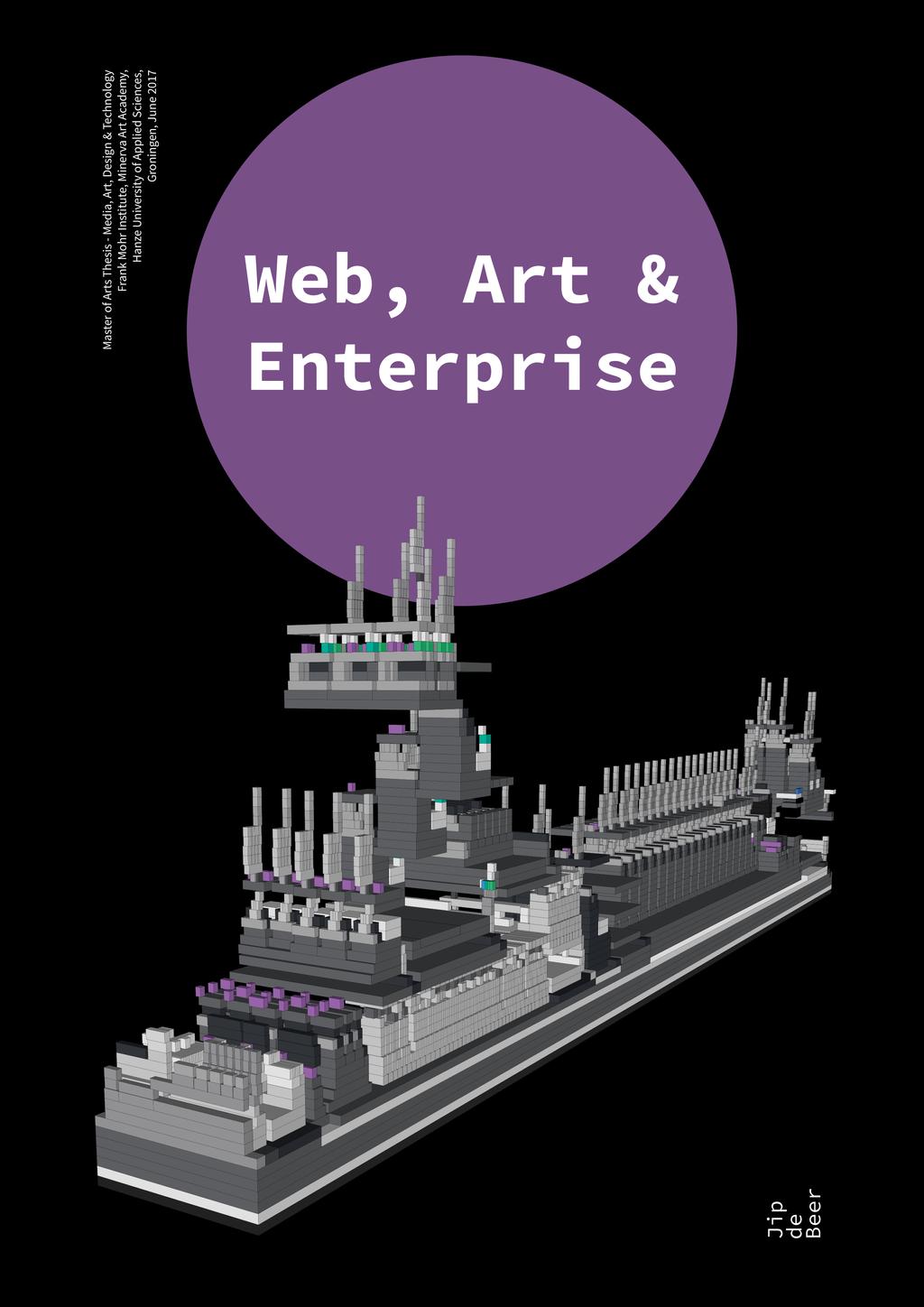
Web, Art & Enterprise

Nothing in this publication may be reproduced, stored in an automated database, or made public, in any form or by any means, either electronically, mechanically, by photocopies, recordings, or any other means without the prior permission of the author.
Thank you for your interest in this information package. It serves as an introduction to the Keynote presentation Web, Art & Enterprise wherein I will convey my master thesis, live, in front of an audience. Until then, you can already look into the information this package provides.
The following pages will continue this introduction with my artist biography, emphasizing my graduation work Web Spaces. This is followed by several pages dedicated to themes within my work and research.
Then following the tab, Presentation, you will find a recording of the Keynote presentation. Following the next tab, E-mail, is where you’ll find the email template I’ve written to contact 10.000 people as part of my research.
Behind the last tab, Sources, you’ll be able to look up the references cited in my thesis. And if you’re wondering what I mean by tabs, that is because you’re reading the digital version of this document instead of the physical binder with actual old school tabs.
Jip de Beer, 2017

About Jip
Like oil paintings (canvas, paint, varnish) web pages are also carefully constructed from many layers. With his Web Spaces Jip de Beer presents the structures that normally remain hidden beneath the surface of web pages. What you see in a web browser is constructed by stacking rectangular elements on top of each other with a variety in size, color and function. Take for example the Google search bar, a visually simple white space, which actually has a very complex structure beneath the surface. When transformed into a 3D printed sculpture, the invisible craftsmanship of these web pages becomes graspable. A flat white surface on our screen turns into a three-dimensional skyscraper, striking associations with architectural models, once again referring to the delicate and time consuming act of building.
His programming skills give Jip de Beer the possibility to exceed the limits of working manually. Like translating every web page of his choice into a 3D structure within a second. Whether or not the web page will be turned into a sculpture is decided by the artist based on the aesthetic qualities of the digital model. With the Web Spaces series De Beer has created a generative method that actually illustrates the manual and time consuming practice hidden behind the digital façade of web pages. His practice oscillates between digital processes of automation and manual labor. To transform the virtual structures into physical sculptures the artist works with 3D printing techniques and a more traditional material: gold. The golden Web Spaces manifest the elusive but valuable digital materials that have become the gold of our time.
Themes
To set the scene, I can tell you that my work is entangled with “The Internet” in every way. I’ll back this claim up by taking some of my works from the past two years as an example. First up: ‘Rapping.Reviews - Computer-generated Rap Battles’. This is a website I finished at the end of 2015. It’s an artistic response to the overload of information on the web. For example users reviews. There are just so many… Therefore the only sane thing to do, is to make rap battles out of them! Rapping.Reviews automatically analyzes the reviews from Movies and TV Series and presents them in the form of a rap battle music video. Curious what people say about a movie? Watch the rap battle! It’s much more entertaining than reading reviews. However, Internet Movie Database (IMDb) reviews are often quite funny or interesting on themselves! That’s why Rapping.Reviews provides the reviews with a stage of their own. Quotes from reviews get a chance to re-surface and make us curious, laugh or wonder. Otherwise, these sentences may become lost in the mass of reviews. Rapping.Reviews is all about re-cycling data that is already there to make something new, with a sense of humor.

The whole project is fully driven by automation: from acquiring the reviews online and composing rap lyrics out of them, to publishing the remixed content (consisting of a movie trailer, rap beat and computer voice) back onto the web. There is no human rapper and no manual labor done by me, which allows my collection of raps to rapidly grow and cover over thirteen thousand individual Movies and TV Series, as well as to be updated automatically, every day. But who cares? Who’s going to watch this?
Rapping.Reviews deals with the topic of information overload, as well as the topic of copyright and authorship. With Rapping.Reviews, I’ve re-purposed sentences found online, without asking permission from the original author. I do give credit to the writers, as to not get into trouble for plagiarism. But this introduces another issue: some people just don’t want their name to be associated with rap. So who is the owner of the content? And what am I allowed to do with it? It’s a legal grey area, especially because there’s another big party involved: Amazon.com owned IMDb whose “Conditions of Use” prohibit my use of the reviews.
Another of my projects where the Internet plays a key role is ‘Web Spaces’. In the image on this page, you see the Web Space of Engadget.com. In this 3D rendering the layers of a web page become apparent. Like with oil painting, where layers of paint are added on top of each other to create the desired image, what you see in a web browser is constructed by stacking elements with varying dimensions, color and function on top of each other. The resulting structure bears a clear resemble to architecture and often has a high order of complexity associated with spaceships or entire cities. With this project I present the world beneath the surface of web pages, which I want to explore out of curiosity.

But my Web Spaces don’t remain digital. I’ve embarked on a mission to translate the hidden architecture of web pages into the physical world by utilizing 3D printing. The precision and automatic nature of this technique perfectly suits the digital origin of web pages. This physicality is a new element in my work, since previously I primarily focused on ‘the screen’. Therefore Web Spaces gives my previous work (as well as every other web page) the opportunity to escape the limits of the second dimension, into our hands. This also opens up ways to distribute my work. With Rapping.Reviews I experimented with a donation business model, while offering the content for free. Web Spaces affords to exhibit and sell physical objects, which may be more fruitful as I didn’t receive a single donation with my previous experiment.
I can 3D print a Web Space based on any existing web page. Including web pages made by other people. Which means, the creator of the web page designed the structure. So does it make me a thief, if I were to use this structure as input for my artwork? Is it plagiarism? Or is my work transformative? Is it art? Is it legal to publish the Web Space using the name of the web page on which it is based? Or will I run into trademark issues? Do I need to ask permission? Can I ask money for (3D) printing a web page? It’s clear that the creator of the original web page plays a big role in defining what my Web Space will look like. As with Rapping.Reviews, I’m collaborating with people who are unaware they’re involved in an artwork. I’m calling this unconscious collaboration.
Because of this unconscious collaboration, both Rapping.Reviews and Web Spaces have the opportunity to appeal to the ego of the people involved. With the raps, the review authors are curious to see their words as part of an artwork and feel honored (not everybody, but most). With Web Spaces the effect can be similar. The creator of the web page has never seen it in such a way before. It’s a totally different view: a total overview. It’s an excellent way to admire the achievement of having created this web page. However, with Web Spaces the ego can also become an obstacle. At the moment I put a price on a Web Space, the creator of the web page on which my work is based may feel that (s)he deserves a portion or even all of the money. Who knows, maybe that’s right. I do profit from the fame of their web page.
One way I investigate my topics of interest (indicated with bold throughout this chapter) is by means of an ongoing email conversation project called ‘Dear IMDb user’. Initially, I tried spreading the word about Rapping.Reviews via influential blogs and social media. But that didn’t drive visitors to my site. I did, however, find an audience in the ‘Bored at work’ network. Rapping.reviews has been featured on pointlesssites.com and was, to my surprise, the ‘pointless site of the day’ for a while. This resulted in visitors on my website, but not in satisfaction for me. I want to connect to the visitors. Get feedback and know their opinion. But this wasn’t happening… It then appeared to me that I could have a potentially large audience in the credits of my project, as I had involved over 106.000 review authors.

I was shocked to discover that over ten thousand of these people list their email address publicly on their IMDb profile. This made it trivial for me to reach them en masse. However, instead of emailing them in one batch, I decided to take a more personal approach (but still within the vibe of automation). I wrote an email template, enclosed as an appendix, which informs the IMDb user that I’ve quoted part of his/her review for my art project and that I’ve given credit for their part. I hope to surprise the reader and also seize the moment to talk about the topic of information overload and privacy. Doing this I found out that lots of people don’t realize their words are (still) out there and that their email address is on public display.

Every day, my program emails thirty individual review authors. The email template is automatically filled with the appropriate data and posted, to both promote my project as well as to establish a connection. So, me reaching out to someone is actually an automated approach. But because of the way I’ve designed my email template, it does initiate personal contact. Whenever someone replies, and this happens on a daily basis too, I take the time to reply manually. It’s not just the ego of the review author being addressed, also very much my own ego… As a result of Dear IMDb user, I receive an very welcome amount of compliments on a daily basis. Almost like fan mail. But fortunately some conversations go beyond the common “thank you well done” message, into a deeper discussion related to the topics of interest.
I’ve been emailing new people for about a year now, so I’m almost through all of the ten thousand email addresses. Currently the archive consists of approximately 1.300 emails, spread out over about four hundred conversations.
Web, Art & Enterprise - Presentation
This is a recording wherein I present my master thesis, live, in front of an audience (Frank Mohr Institute Exam Committee and fellow students).
Dear IMDb User Email Template
Dear <username>,
I found your email address on your IMDb profile. As part of my Rapping.Reviews art project I have quoted the following part from your IMDb review of <title of film/series>: <quoted sentence>.
I thought it would be fun to make a rhyme with it! Hence I picked a second phrase from a review of <title of film/series> which rhymes to <last word of quoted sentence>. I actually let the computer do this automatically and the result is a rhyming computer generated rap battle review of <title of film/series>, of which you are the co-writer! I've obviously given you credit for writing your part of the lyrics. You can check out the rap battle music video, starring your sentence, here.
The whole project is a bit hard to explain, so I made a trailer to show you more effectively. You can check it out on YouTube.
Hopefully I surprised you (in a good way), because this project really surprises me all the time. The rap battle lyrics are compiled by an algorithm which takes into account rhyme, how positive or negative your sentence is and randomness. The unpredictable outcome, background video and speech synthesizer allow for unintended interpretations, new meaning and fun. Some raps work well, some don't - that's part of the joke and to be expected from computer generated content.
But it's not all fun and entertainment. Rapping.Reviews is a reaction on the overload of data available to humans. News, Social Media, Analytics... What are we supposed to do with all this data? For example, there are literally millions of IMDb reviews... How many will go unnoticed? With my project I try to re-surface parts of IMDb reviews and give the review authors (like you) a place in the spotlight. The underlying theme is 'big data', which also has privacy implications. Have you ever thought about the information you distribute and share online? For example your email address is listed publicly on the Internet. Do you ever worry about what others might do with your information? It concerns me. Especially that it's so difficult to keep control over 'your own' data.
You can read more about the concept of Rapping.Reviews on the about page.
I'm studying for Master of Fine Arts, I'm very passionate about technology and I like to make film/video projects. I've always wanted to share my work with many people. But it's not easy to consistently publish new content and grow a fan base. So for the past year I've been working on Rapping.Reviews in the hope that it's interesting, up to date and entertaining enough to reach a large audience. Feel free to share it if you like.
By the way, you're not subscribed to some spam mass mailing list. If you ignore this email I won't contact you again. If you have any questions, I look forward to your reply.
Thanks again for contributing your IMDb review to the web!
Keep it up, perhaps your next review will be quoted too :)
Best regards,
Jip de Beer
Creator of Rapping.Reviews
Personal blog Jip.deBeer.IT and LinkedIn profile
Rapping.Reviews on YouTube, Facebook and Twitter
Sources
- Vall, René Van De. “The Mediation of Passibility: Art and Interactive Spectatorship.” At the Edges of Vision: A Phenomenological Aesthetics of Contemporary Spectatorship. Aldershot, England: Ashgate, 2008.
- Jacobs, Ruben. Iedereen een kunstenaar: over authenticiteit, kunstenaarschap en de creatieve industrie. Rotterdam: V2_Publishing, 2014.
- Lindeborg, Lisbeth, and Lars Lindkvist, eds. The Value of Arts and Culture for Regional Development: A Scandinavian Perspective. Regions and Cities. London: Routledge, 2014.
- Rozendaal, Rafaël. Personal interview. 26 October 2016.
- Veldhuijzen van Zanten, Boris. Personal interview. 29 May 2017.
- Renema, Jasper. Personal interview. 20 April 2017.
- “Afweersysteem stress stamt nog uit de oertijd.” Nieuwsuur. NOS, 9 Feb. 2017. Web. 01 June 2017.
- Weller, Chris. “Elon Musk Doubles down on Universal Basic Income: ‘It’s Going to Be Necessary’.” Business Insider. N.p., 13 Feb. 2017. Web. 01 June 2017.
- Hundreds of IMDb users I’ve been having a dialoge with



